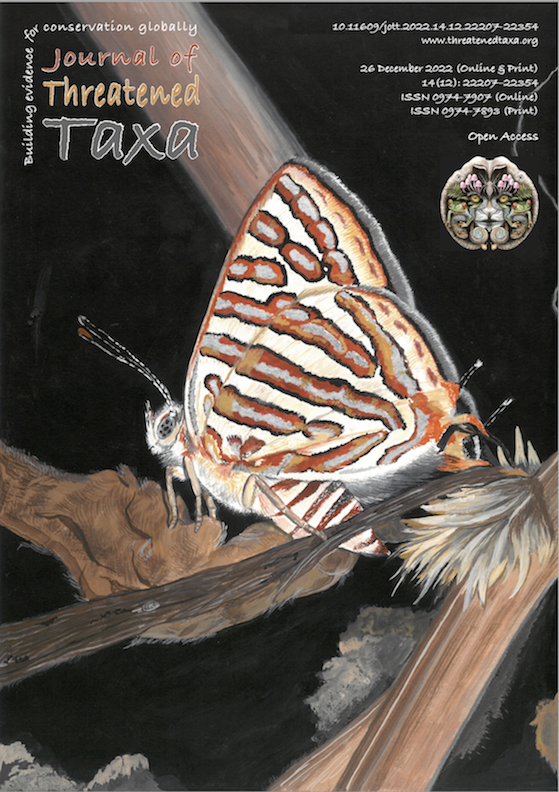First photographic record of Spotted Deer Axis axis (Erxleben, 1777) (Artiodactyla: Cervidae) in Great Indian Bustard Sanctuary, Maharashtra, India
Main Article Content
Abstract
Axis axis also known as Chital, Spotted Deer or Axis Deer, is native to Asia. The Chital ranges over 8–30 0N in India and through Nepal, Bhutan, Bangladesh, and Sri Lanka. Chital is listed as Least Concern in the IUCN Red List of Threatened Species because it possesses a very wide range, however, the population is declining outside protected areas. Although widely distributed, there is no record of Chital from the Great Indian Bustard (GIB) Sanctuary, Maharashtra. Here we report the first photographic record of Chital from the sanctuary, in the Gangewadi region of Solapur District. During a field work exercise for radio collaring of Indian Grey Wolves to monitor movement in the human-dominated landscape of Maharashtra, camera traps were placed in the Gangewadi area of the GIB sanctuary. Over the survey period, the species that were photo-captured included the Indian Grey Wolves, Indian Fox, Jungle Cat, Black Buck, Wild Boar, porcupine, and Black-naped Hare on multiple occasions. The male Spotted Deer was captured at one event in a single camera trap (17.83240N, 76.00430E) on 30 December 2020 at 0517 h. This is the first record of Spotted Deer in the grassland ecosystem of Solapur region in Maharashtra.
Article Details

This work is licensed under a Creative Commons Attribution 4.0 International License.
Authors own the copyright to the articles published in JoTT. This is indicated explicitly in each publication. The authors grant permission to the publisher Wildlife Information Liaison Development (WILD) Society to publish the article in the Journal of Threatened Taxa. The authors recognize WILD as the original publisher, and to sell hard copies of the Journal and article to any buyer. JoTT is registered under the Creative Commons Attribution 4.0 International License (CC BY), which allows authors to retain copyright ownership. Under this license the authors allow anyone to download, cite, use the data, modify, reprint, copy and distribute provided the authors and source of publication are credited through appropriate citations (e.g., Son et al. (2016). Bats (Mammalia: Chiroptera) of the southeastern Truong Son Mountains, Quang Ngai Province, Vietnam. Journal of Threatened Taxa 8(7): 8953–8969. https://doi.org/10.11609/jott.2785.8.7.8953-8969). Users of the data do not require specific permission from the authors or the publisher.
Funding data
-
Department of Science and Technology, Ministry of Science and Technology, India
Grant numbers EMR/2015/000036
References
Anderson S.B. (1999). Axis Deer overview and profile. http://www.hear.org/hnis/reports/ hnis-axiaxiv01.pdf. Accessed on 10 December 2021.
Crandall, L.S. (1964). The management of wild mammals in captivity. University of Chicago Press, Chicago, 769 pp.
Duckworth, J.W., N.S. Kumar, I.M. Anwarul, B.H. Sagar & R. Timmins (2015). Axis axis. IUCN Red List of Threatened Species. e.T41783A22158006. Accessed on 01 December 2021. https://doi.org/10.2305/IUCN.UK.2015-4.RLTS.T41783A22158006.en
Grubb, P. (2005). Artiodactyla, pp. 637–722. In: Wilson, D.E. & D.M. Reeder (eds.). Mammal Species of the World. A Taxonomic and Geographic Reference (3rd edition). Johns Hopkins University Press, Baltimore, USA, 2142 pp.
Habib B. (2007). Ecology of Indian Wolf Canis lupus pallipes (Sykes, 1831), and modelling its potential habitat in the Great Indian Bustard Sanctuary, Maharashtra, India. PhD Thesis. Department of Wildlife Sciences, Aligarh Muslim University, 270 pp.
Habib, B. & S. Kumar (2007). Den shifting by wolves in semi wild landscapes in the Deccan Plateau, Maharashtra, India. Journal of Zoology 272(3): 259–265.
Janakiraman, J. & J. Jalal (2015). Angiosperm diversity of the Great Indian Bustard Wildlife Sanctuary: a semi-arid grassland, Maharashtra, India. Check List 11(2): 1–20. https://doi.org/10.15560/11.2.1602
Khan, S., N. Chatterjee & B. Habib (2019). Testing performance of large-scale surveys in determining trends for the Critically Endangered Great Indian Bustard Ardeotis nigriceps. Scientific Reports 9(1): 1–8. https://doi.org/10.1038/s41598-019-48193-2
Kumar, S. (1998). Ecology and Behaviour of Indian Grey Wolf Canis iupus pallipes (Sykes 1831) in the Deccan Grasslands of Solapur, Maharashtra. PhD Thesis. Department of Wildlife Sciences, Aligarh Muslim University, 215 pp.
Kumar, S. & A.R. Rahmani (2008). Predation by wolves Canis lupus pallipes on Black Buck Antilope cervicapra in the Great Indian Bustard Sanctuary, Nannaj, Maharashtra, India. International Journal of Ecological Environmental Science 34(2): 99–112.
Long, J.L. (2003). Introduced Mammals of the World, Their History Distribution and Influence. CSIRO Publishing, Melbourne, Australia, 589 pp.
Nowak, R.M. (1991). Walker’s mammals of the world. 5th edition. John Hopkins University Press, Baltimore, 1629 pp.
Phadnis, M. (2017). Strays kill thirsty deer. Pune Mirror. https://punemirror.indiatimes.com/pune/civic/man-asks-two-to-lower-voice-but-gets-beaten-up/articleshow/56673239.cms Accessed on 12 February 2021.
Rahmani, A.R. (1988). The conservation of the Great Indian Bustard Ardeotis nigriceps (Vigors) in the Karera Bustard Sanctuary. Biological Conservation 46(2): 135–144.
Sankar, K. & B. Acharya (2004). Chital Axis axis (Erxleben 1777). pp171–180. In: Sankar, K. & S.P. Goyal (eds.). Ungulates of India. Wildlife Institute of India, Dehradun, India. ENVIS Bulletin Wildlife Institute of India, Dehra Dun, 448 pp.
Schaller, G.B. (1967). The Deer and the Tiger: A Study of Wildlife in India, University of Chicago Press, Chicago and London, 370 pp.
The Golden Sparrow (2016). Spotted Deer found dead near garbage pit in Warje. The Golden Sparrow, Weekly newspaper, Pune. https://medium.com/the-golden-sparrow/spotted-deer-found-dead-near-garbage-pit-in-warje-62677f07f0ac. Accessed on 12 February 2021.
Vanak, A.T. & M.E. Gompper (2010). Multi‐scale resource selection and spatial ecology of the Indian Fox in a human‐dominated dry grassland ecosystem. Journal of Zoology 281(2): 140–148.
Varghese, A.O., V.B. Sawarkar, Y.L. Rao Y.L. & A.K. Joshi (2016). Habitat suitability assessment of Ardeotis nigriceps (Vigors) in Great Indian Bustard Sanctuary, Maharashtra (India) using remote sensing and GIS. Journal of the Indian Society of Remote Sensing 44(1): 49–57.
Walker, E.P. (1964). Mammals of the World. Johns Hopkins Press. Baltimore, 2268 pp.

